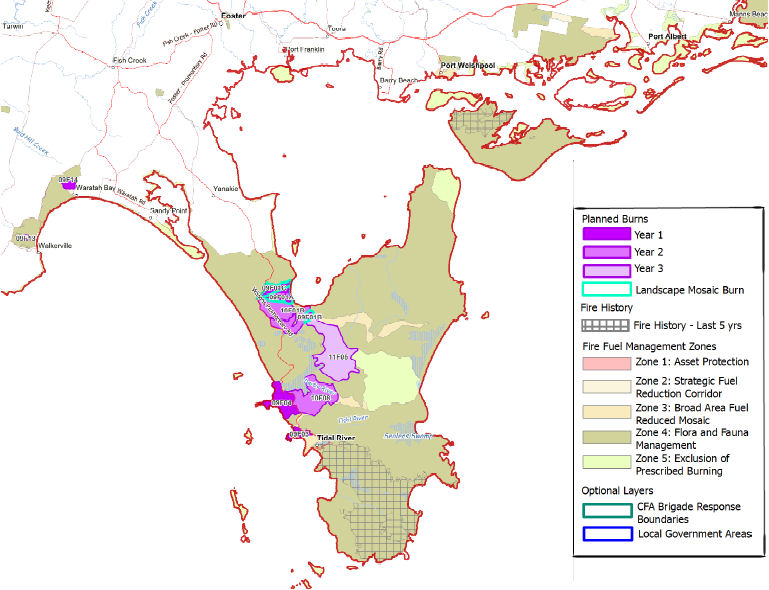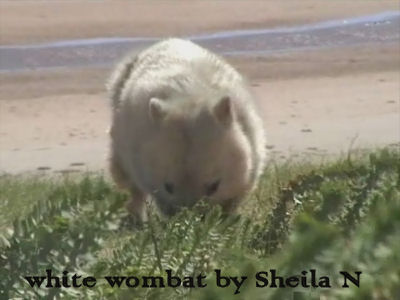
During February's bushfires, the Victorian government's Department of Sustainability and Environment (DSE) has allowed nearly all of the natural ecology of the northern half of Wilsons Promontory to burn. Is the Prom fire (now having destroyed 24,800 hectares of native habitat) being deliberately left to burn by DSE? DSE and CFA have protected private property at Tidal River and Yanakie. So is what's really happening down at the Prom away from public scrutiny?
See also "Wilsons Promontory – DSE fire management risking local extinctions" of 26 Feb 09.
During February's bushfires, the Victorian government's Department of Sustainability and Environment (DSE) has allowed nearly all of the natural ecology of the northern half of Wilsons Promontory National Park (The Prom) to burn.
 Out of control? Lack of resources? Or has The Prom fire (now having destroyed 24,800 hectares of native habitat) in fact been deliberately left to burn? DSE in collaboration with the Victorian Government's CFA have protected private property at Tidal River and Yanakie. So what really has been going on at The Prom behind the fire barricade out of public view? Why was the small fire north of Sealers Cove not extinguished on Friday 13th February when it was nearly out? Why after three weeks with mild weather conditions has this wildfire not been put out? Why, ahead of more forecast hot winds, has DSE risked this fire continuing?
Out of control? Lack of resources? Or has The Prom fire (now having destroyed 24,800 hectares of native habitat) in fact been deliberately left to burn? DSE in collaboration with the Victorian Government's CFA have protected private property at Tidal River and Yanakie. So what really has been going on at The Prom behind the fire barricade out of public view? Why was the small fire north of Sealers Cove not extinguished on Friday 13th February when it was nearly out? Why after three weeks with mild weather conditions has this wildfire not been put out? Why, ahead of more forecast hot winds, has DSE risked this fire continuing?
Is this in fact an opportunistic prescribed burn...thanks to lightning? Is it in fact because the DSE doesn't want the fire out..not until its prescribed burn area is burnt?
A DSE operational fire planning document sourced from the Yarram Fire Distict (which includes The Prom) shows that most of The Prom that has now been burnt is in fact part of DSE's 'Planned Burns' for 2009, 2010 and 2011 anyway. The DSE map (attached) shows no fires history for the northern half of The Prom.
...'so quick let's burn it, lest it burns!'

[CLICK MAP TO ENLARGE] Yarram Fire Operations Plan 2008/09 - 2010/11 - showing most of Wilsons Promontory colour coded for planned burning. ©Firemap Tue 14th Oct 2008
On this DSE planned burn map of The Prom, no areas are off limits from burning save the few villages and small pockets of private property and what the DSE has mapped as Zone 5 'Exclusion of Prescribed Burning'.
All other natural bushland areas of The Prom have been targeted by DSE for burning anyway.
This prescribed burning culture labels all bush hazardous 'fuel' and a demonic threat. Instead of putting out the fires in bushland they let the bush burn and all the native animals burn alive in the process.
They brag... 'we save houses, the bush will grow back so what's the problem?'
The 'Department for Sparks and Embers' is living up to its name.
But who's responsible for the fauna?

See also "Wilsons Promontory – DSE fire management risking local extinctions" of 26 Feb 09.

Comments
Prudence C. (not verified)
Wed, 2009-03-04 22:38
Permalink
Is DSE helping developers get at the Prom??
callum (not verified)
Sun, 2009-03-22 16:55
Permalink
Vic DSE's handling of Wilson's Promontory fire defended
Tigerquoll
Thu, 2009-03-26 00:00
Permalink
DSE's prom effort was opportunistic prescribed burning
Anonymous (not verified)
Tue, 2009-04-14 16:57
Permalink
A large number of native
Tigerquoll
Tue, 2009-04-14 23:45
Permalink
Let the DSE publicly justify its actions
Anonymous (not verified)
Sat, 2010-05-01 13:31
Permalink
Conservation biologist disputes that burn-offs harm ecology
Milly (not verified)
Sat, 2010-05-01 18:01
Permalink
Feeling "sorry" for the "cute and fluffy animals" is sickening
Tigerquoll
Mon, 2010-05-03 09:41
Permalink
Bushfire authorities: underfunded dad's armies playing with fire
artemis (not verified)
Mon, 2009-07-20 14:55
Permalink
Your comments appear only half-educated
Tigerquoll
Tue, 2009-07-21 00:01
Permalink
Prescribed burning is based on unsupported myths
Anonymous (not verified)
Tue, 2009-07-21 00:18
Permalink
Logging is drying our forests!
By "managing" our forests and clearing native vegetation, along with the conditions of drought and climate change, we are actually making them drier and less dense, and thus adding to the risk of mega-fires.
While our State government continues to permit the logging and thinning of our native forests and water catchment areas, the public can do little to prevent further mega fires.
The dry conditions means that trees suffer and compete for water. They lose their leaves, or die, thus exacerbating the dry undergrowth problem. Instead of moisture, forests continue to become more vulnerable. It is then a cycle downwards to damaged ecosystems, and thus more fire dangers.
Tigerquoll
Tue, 2009-07-21 11:50
Permalink
Broadscale frequent prescribed burning is a threatening process
Indeed, logging, thinning and frequent burning (forest practices) over Australia's 220 year colonial history have and continue to destroy the integrity of our native forests and force our native fauna closer to extinction. Colonial 'clearing' for agriculture and building materials destroyed most of south eastern Australia's natural landscape. Neo-colonial practices including unchecked urban invasion and prescribed burning continue to do destroy what's left.
Australia's original natural landscape is characterised by varied topography and varied mosaics of different vegetation types. Broad scale destruction of native vegetation across south eastern Australia has reduced the remnant forest and heath habitat into fragmented and isolated islands. Many specific habitat types are now threatened and endangered as a consequence. Wet schelophyll has being transformed into dry schlerophyll. Note the fire resistent species that return after a fire - Acacias (wattles), tea tree and Eucalypts. These then dominate the new growth and when the next fire occurs they burn more intensely and exacerbate the wildfire. Frequent prescribed burning makes our remnant forests more susceptible to wildfire. Frequent prescribed burning and uncontrolled broadscale bushfire are by area and impact are responsible for the loss of our remaining biodiversity and ecological values across south eastern Australia.
This is even though prescribed burning has been found not to prevent ember attack - the main cause of wildfire spread in extreme bushfire weather conditions! Frequent broadacre burning policies have limited effectiveness at mitigating wildfire risk (its intended aim). The previous "NSW Rural Fire Service Commissioner, Phil Koperberg, echoed similar sentiments when faced with criticism after the 2002 fires: ‘Unless you’re going to keep all of New South Wales hazard reduced to a point where there is no fuel on the ground…we’re going to have fires’ (McKey 2002)." SOURCE: http://www.australianreview.net/digest/2003/02/brandes.html
ACB Submission to the Teague Commission on Victoria's 2009 Bushfires
The Australian Centre for Biodiversity (ACB) at Monash University has made a submission to Teague Commission on Victoria's 2009 Bushfires, and addresses the fundamental question: 'Can fire and land management practices and policies be modified to minimise the future risk of similarly catastrophic bushfires without compromising Victoria's native ecosystems and the biodiversity that they support?'
ACB in its submission, has offered the following warnings of how broadscale frequent burning threatens our native forests:
"Natural fire is a complex physical process that affects organisms, communities, and landscapes in various ways. The spatial and temporal variability of these impacts depends on the intensity and frequency of fires in an area, that is, the fire regime."
"Inevitably, after a major bushfire, there are calls to increase the amount and frequency of fuel reduction burns. However, increasing the rate of fuel-reduction burns is, in effect, changing the fire regime in an ecosystem and may have substantial ecological implications.
"The application of fuel-reduction burning to mitigate fire risk, therefore, needs to be critically questioned on two fronts.
First, will increasing the frequency and amount of prescribed burning reduce fire risks at the landscape scale?
Second, how will changing the fire regime through increased fuel-reduction burning impact on native ecosystems? Will increasing fuel-reduction burning lower fire risks?
"Theoretical studies have also shown that fuel-reduction burning at the landscape scale can reduce the risk of large, catastrophic fires. However, these studies make important assumptions about the other point of the fire triangle: climate. Under most reasonable climatic conditions, fuel reduction burns done sufficiently frequently may reduce the risk of large fires. However, under extreme climatic conditions, such as those that preceded Black Saturday, this may not hold. As of Friday, 6 February 2009, approximately one-third of Victoria’s public lands had been subjected to fuel-reduction burns since 2003; that is, ~5% of public lands were subjected to fuel-reduction burns each year. This was the target set in an earlier Parliamentary Enquiry and clearly did not prevent the Black Saturday fires. Modeling studies suggest that the amount of fuel reduction burns would need to be doubled, at least, to have any potential for avoiding similarly catastrophic fires if conditions of such extreme fire danger re-occur in the future."
"Increasing fuel-reduction burning to proposed levels (10-15% of public lands per year) would reduce habitat diversity by homogenizing the regional fire regime. The diversity of habitats and their mosaic distribution across the Victorian landscape is a critical component in maintaining local and regional biodiversity. The interdigitation of sites differing in their susceptibility to fire provides temporary refuges for animals that can move away from fires and later recolonise their original sites. More frequent fuel-reduction burning will change the structure and composition of the understorey vegetation. While many animals may be better able to survive the low-intensity fuelreduction, the resultant vegetation may be poor-quality habitat."
"Applying a single prescribed burning policy to Victoria’s public lands will disadvantage a large proportion of the native biodiversity and reduce local and regional habitat diversity. Shifting
toward more homogeneous landscapes through increased prescribed burning will be detrimental to the long-term conservation of biodiversity in Victoria."
"Increased prescribed burning may reduce fire risks in some years, but is unlikely to have any effect in those years with extreme climatic conditions similar to those of 2009."
"A uniform and widespread increase in fuel-reduction burning across Victoria’s public lands will likely have negative long-term impacts on the native flora and fauna."
ACB's recommendation:
"We recommend that the State government consider a more nuanced policy that acknowledges the spatial complexity of Victoria’s landscapes and the values associated with them. We recommend that increased prescribed burning be focused in high-risk areas directly surrounding towns to minimize threats to people and property. However, for more remote, unpopulated areas, where the primary values are biodiversity and timber, we believe that fire management plans should be based on the best available science, that they should be consistent with the appropriate historical fire regimes, and that they provide an integrated, long-term vision for Victoria’s natural heritage."
SOURCE: www.biolsci.monash.edu.au/research/acb/docs/teague-commission.pdf
Add comment